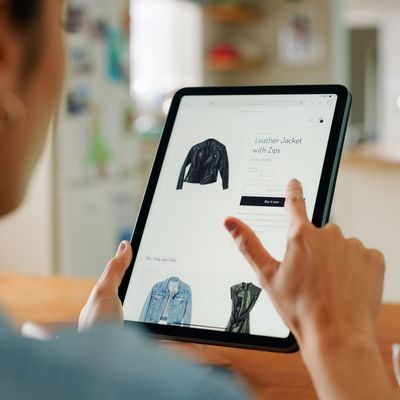
Photo: Bevan Goldswain/Getty Images
Are Trump’s tariffs going to be the nail in the coffin for a fashion industry that already feels on life support? On social media, consumers are starting to worry that the answer is yes.
On Wednesday, President Donald Trump announced sweeping tariffs on imported goods — a 10 percent baseline tariff on all imports and varying, seemingly arbitrary, rates on certain trade partners like China, slapped with a 34 percent tariff, and the European Union with a 20 percent tariff. Much of our clothing (97 percent of apparel and shoesto be exact) and cosmetics in the US are manufactured in countries like Bangladesh, Indonesia, and China. Even American-made brands often have a portion of their supply chain abroad, meaning these tariffs will saddle the companies importing these products with the increased costs, which will eventually reflect as an increased price in goods for the consumer, ie, you and me.
The tariffs just went into effect, but shoppers are already freaking out. It’s still unclear exactly how much prices will go up, but via PBS, apparel prices are projected to increase 17 percent. Jeremy Freed, a writer at GQspells it out in a hypothetical like this: If an American brand imports T-shirts from Vietnam for $10, “and there’s a 46% tariff on imports from Vietnam, the importer will have to pay an additional $4.60 in tax, bringing their total cost for importing those shirts to $14.60.” According to Barron’seight out of ten consumers are concerned about how these new costs will impact their shopping, and across social media, the fashion-obsessed are airing their concerns.
“Someone be real, can I still buy on Shein?” someone asked on TikTok. “The tariffs thing? I don’t understand any of this. I just wanna shop.” One user said they panic-purchased several items off Temu in preparation for the tariffs hitting, and another posted a video of what they believed to be their last Temu order. Since Shein and Temu both ship from China, they’ll be hit with an additional 34 percent tax, which might leave consumers to make up the difference. Perhaps one tiny silver lining will be fewer Shein hauls ending up in landfills.
Fans of Ssense, an international, high-end stockist based in Canada, are equally losing their minds. In February, Trump announced a 25 percent fee on Canadian imports. “Y’all talking about losing SHEIN, bitch I’m about to lose Ssense,” someone lamented. “I just found out Ssense has 25% tariffs. Everything has high taxes now. I’m having a panic attack. Their private sale was my religion…” another posted. Others have posted their final Ssense unboxings; one caption reads, “Worse than heartbreak tbh.”
Founders of consumer-favorite brands are also expressing concern. Andrew Chen, co-founder of 3sixteen, a small menswear brand with a cult following, posted a video he “wasn’t looking forward to making.” His brand imports fabric from Portugal, India, and Japan, and “a $10 increase in raw materials is going to be a $40 to $50 increase in cost,” he said. Along with increased costs, Chen mentioned how uncertain he felt about the future of his brand and how these tariffs would lead to a deterioration of overseas markets — for example, international stockists no longer carrying the brand. He also noted that these tariffs will not guarantee a shift back to domestic manufacturing.
Liah Yoo, the founder of the popular K-beauty brand Krave, posted on TikTok alerting her followers that “as of today, K-beauty will no longer be affordable,” noting that in her seven years in business, her brand has never raised prices, but with Trump’s tariffs in place, she’ll now be forced to do so. “Our next shipment from South Korea will be hit with a 25 percent tariff,” she says. “This will have to be passed on to the customers. Any brands who create products, their supply chain is international. This impacts every brand.” One commenter wrote, “Going back to bar soap at this point.” At this point, it’s starting to look like many of us will follow suit.